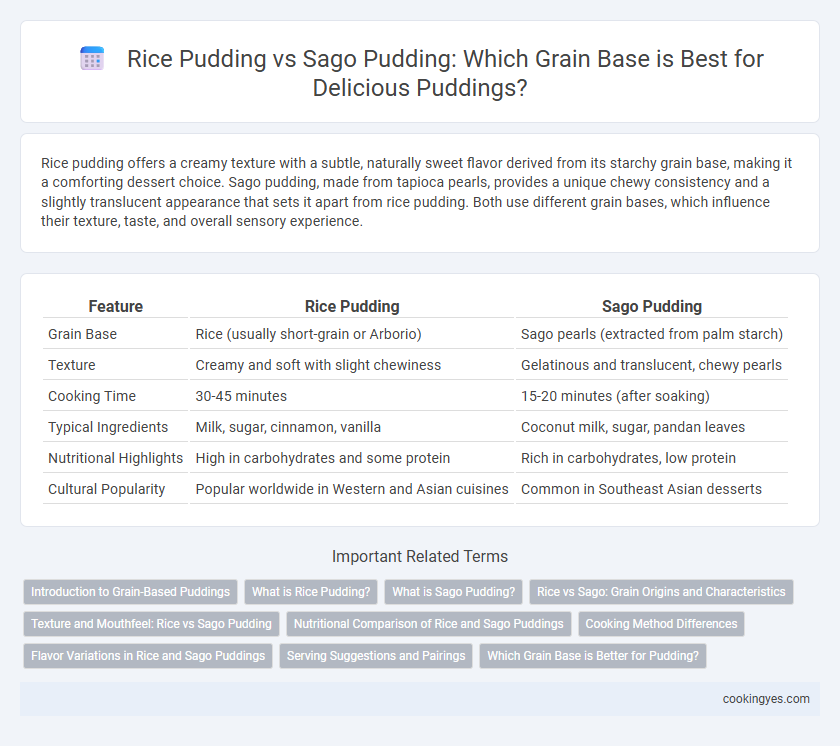Rice pudding offers a creamy texture with a subtle, naturally sweet flavor derived from its starchy grain base, making it a comforting dessert choice. Sago pudding, made from tapioca pearls, provides a unique chewy consistency and a slightly translucent appearance that sets it apart from rice pudding. Both use different grain bases, which influence their texture, taste, and overall sensory experience.
Table of Comparison
| Feature | Rice Pudding | Sago Pudding |
|---|---|---|
| Grain Base | Rice (usually short-grain or Arborio) | Sago pearls (extracted from palm starch) |
| Texture | Creamy and soft with slight chewiness | Gelatinous and translucent, chewy pearls |
| Cooking Time | 30-45 minutes | 15-20 minutes (after soaking) |
| Typical Ingredients | Milk, sugar, cinnamon, vanilla | Coconut milk, sugar, pandan leaves |
| Nutritional Highlights | High in carbohydrates and some protein | Rich in carbohydrates, low protein |
| Cultural Popularity | Popular worldwide in Western and Asian cuisines | Common in Southeast Asian desserts |
Introduction to Grain-Based Puddings
Rice pudding and sago pudding are classic grain-based desserts popular in many cultures around the world. Rice pudding uses short or medium-grain rice, which becomes creamy and soft when cooked in milk or coconut milk, offering a rich texture and subtly sweet flavor. Sago pudding, made from small, translucent starch pearls derived from tropical palms, provides a chewy texture and is often paired with coconut milk or sweet syrups to enhance its delicate taste.
What is Rice Pudding?
Rice pudding is a creamy dessert made from starchy rice grains cooked in milk or coconut milk, often sweetened with sugar and flavored with cinnamon, vanilla, or cardamom. It provides a smooth texture with soft rice grains that absorb the liquid, creating a rich and comforting consistency. Compared to sago pudding, which uses small tapioca pearls, rice pudding features a more substantial grain base that delivers a chewier bite and a hearty mouthfeel.
What is Sago Pudding?
Sago pudding is a traditional dessert made from sago pearls extracted from the pith of tropical palm stems, offering a chewy texture distinct from the creamy consistency of rice pudding, which uses rice grains as its base. Sago pearls are translucent and gelatinous when cooked, providing a unique mouthfeel compared to the soft, starchy grains in rice pudding. This pudding is often flavored with coconut milk and sweeteners, making it a popular choice in Southeast Asian cuisines where sago is a staple ingredient.
Rice vs Sago: Grain Origins and Characteristics
Rice pudding and sago pudding differ significantly in their grain origins and characteristics, with rice being a staple cereal grain harvested from Oryza sativa and sago derived from the pith of tropical palm stems, primarily Metroxylon species. Rice grains are known for their high starch content, subtle flavor, and ability to absorb liquids, creating a creamy texture in pudding, whereas sago pearls are almost pure starch, offering a more gelatinous and chewy consistency. The nutritional profiles vary as rice contains more protein and essential nutrients while sago is predominantly carbohydrate-based, making each suitable for different dietary preferences and culinary textures.
Texture and Mouthfeel: Rice vs Sago Pudding
Rice pudding presents a creamy, slightly grainy texture that offers a satisfying chew, enhancing the mouthfeel with a hearty consistency. In contrast, sago pudding features a smooth, jelly-like texture with translucent pearls that provide a distinctive, soft pop with each bite. The choice between rice and sago as a grain base significantly impacts the pudding's overall sensory experience, balancing chewiness and silkiness.
Nutritional Comparison of Rice and Sago Puddings
Rice pudding contains higher fiber and protein levels compared to sago pudding, contributing to better digestion and satiety. Sago pudding is primarily composed of carbohydrates with low fat and protein content, offering quick energy but fewer nutrients overall. Rice pudding also provides essential vitamins like B-complex and minerals such as manganese, which are less prevalent in sago pudding.
Cooking Method Differences
Rice pudding uses whole or broken rice grains simmered slowly in milk or water until soft, allowing the starch to release and thicken the mixture naturally. Sago pudding, made from small, translucent sago pearls, requires boiling until the pearls become gelatinous and translucent, resulting in a chewy texture. The key cooking difference lies in rice needing longer, gentle simmering for creaminess, while sago demands vigorous boiling and frequent stirring to avoid clumping.
Flavor Variations in Rice and Sago Puddings
Rice pudding offers a creamy texture with a mild, sweet flavor that absorbs spices like cinnamon and cardamom, creating a rich and aromatic dessert experience. Sago pudding boasts a unique chewy texture, imparting a subtly sweet taste that pairs well with coconut milk and tropical flavors such as pandan or mango. Flavor variations in rice pudding tend toward warm spices and dairy richness, while sago pudding emphasizes tropical and fruity notes enhanced by its distinctive grain base.
Serving Suggestions and Pairings
Rice pudding's creamy texture pairs beautifully with warm spices like cinnamon and nutmeg, making it ideal for serving with fresh fruit compotes or caramel sauce. Sago pudding, known for its translucent pearls, complements tropical flavors such as mango or coconut milk, enhancing its light and refreshing appeal. Both puddings benefit from garnishes like toasted nuts or a sprinkle of cardamom to elevate their grain base character.
Which Grain Base is Better for Pudding?
Rice pudding offers a creamy texture with a mild flavor, making it ideal for absorbing spices and sweeteners, while sago pudding provides a chewy consistency and a translucent appearance that enhances visual appeal. Nutritionally, rice contains more carbohydrates and fiber compared to sago, which is primarily starch with fewer nutrients, making rice a more balanced grain base for pudding. Taste preference and desired texture play crucial roles, but from a health and versatility perspective, rice generally ranks as the better grain base for pudding.
Rice pudding vs Sago pudding for grain base Infographic

 cookingyes.com
cookingyes.com